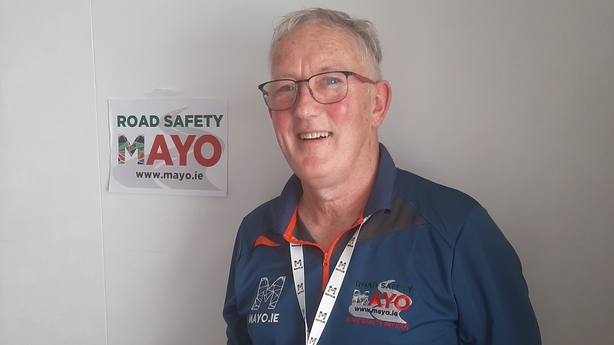Latest data has revealed that in the first nine months of this year, ten Irish counties - including Tipperary, Galway and Mayo - have already matched or exceeded the number of lives lost on their roads in 2022.
Concerns over the number of lives lost on roads in a number of western counties are growing, with 12 deaths in Co Galway so far this year and 11 fatalities in neighbouring Mayo.
But what measures are effective in response to road safety concerns in rural areas?
In the final of a two-part series, our reporter Sally-Ann Barrett travelled to the town of Swinford in Co Mayo where road design and driver behaviour are coming under the spotlight.
The N5 just outside the town of Swinford in Co Mayo is a route now notorious due to the high number of fatal and serious injury collisions there.
A recent inquest led to the coroner for the District of Mayo, Pat O'Connor, repeating his previous calls for safety improvements to several junctions along a 3km section of the route from the intersection of the old Charlestown road, with the N5 National Road at Culmore, westwards as far as Ballymiles.
"In my time alone, there have been over a dozen deaths and there have been dozens of people seriously injured," he said.
Under the Coroners Act, coroners have the power to make recommendations in the public interest where there are concerns if those recommendations are likely to lead to deaths being avoided in the future.

In 2020, Mr O' Connor recommended that a road safety review would be carried out on the N5 near Swinford, but feels his recommendations do not appear to have been acted upon.
In response, Mayo County Council said it hopes to begin construction on a junction improvement scheme along the N5 early next year and a wider safety strategy is under way.
In the meantime, based on the latest collision data, senior gardaí have recommended that the N5 outside Swinford be added to the list of locations where additional GoSafe camera hours will be rolled out.
"With the resources that we have, certainly a targeted approach across all the divisions in the northwestern region is being adopted and it's about making the most efficient use of the resources that we have," said Chief Superintendent Sean Colleran of the northwestern region.
He is also very much aware that there are concerns over enforcement and visibility of An Garda Síochána.
"There was a slowdown on recruitment for multiple reasons. We had the Covid challenges and certainly I would expect the numbers to increase in terms of the dedicated rules policing unit. But all gardaí on duty have a have an obligation in terms of the enforcement of road traffic legislation," he said.
"So it's not just the roads policing unit, it's the operation unit and indeed it's all other gardai on duty."
Mayo Road Safety Officer Gary Smith has been analysing the fatal collisions in which 11 people died in the county so far this year.

There are a number of findings he intends to focus on.
"Male drivers are one of the areas. Seven out of the 11 were male drivers. We look at where the accidents took place. They were on high-speed roads. Three of those 11 were teenagers," he said.
In the coming months, gardaí will begin visiting schools to deliver the new lifesaver programme, a nationwide education initiative focusing on Transition Year students.
The programme will be rolled out during quarter four of this year.
We need your consent to load this Datawrapper contentWe use Datawrapper to manage extra content that can set cookies on your device and collect data about your activity. Please review their details and accept them to load the content.Manage Preferences
It is a measure that Chief Superintendent Sean Colleran believes will have an impact.
"It's about basically informing them of the challenges and of the risks associated with not complying with road traffic legislation," he said.
"Speed limits are one thing, but really, it's about the behaviour and awareness of the students. It's very important and I think these TY students are those that are going to become are the next generation of drivers."
Minister for Education Norma Foley has asked the Road Safety Authority to explore ways to improve road safety education with schools, which could ultimately see road safety lessons for Leaving Cert students on the cards.
In neighbouring Galway, where road fatalities have increased this year by 100%, a number of Transition Year students from Presentation College Athenry believe such a measure could make a difference.

"A lot of people then would learn to drive properly in school and they get experienced before they go out on the road. If you were to do it outside of school, not everyone would give their full 100%, but in school you have to," one student said.
Back in Mayo, Mr O’Connor believes more focus on road design following a loss of life could also reverse the worrying road safety trends.
"The legislation should be approved to make it... I'm not saying mandatory, but certainly compulsory on the various authorities to take into account what coroners say," he said.
"Because it is extremely frustrating to be making recommendations where there clearly needs to be work done on the roads. And unfortunately, then there are further accidents and further fatalities and further injuries within a relatively short period of time."
In a bid to save lives, Mr Colleran has appealed to all road users to be cautious.
"The figures certainly are shocking this year nationally. I expect those figures to drop," he added.
"I think driver behaviour, I think education, I think road users, I think everyone has a part to play."







